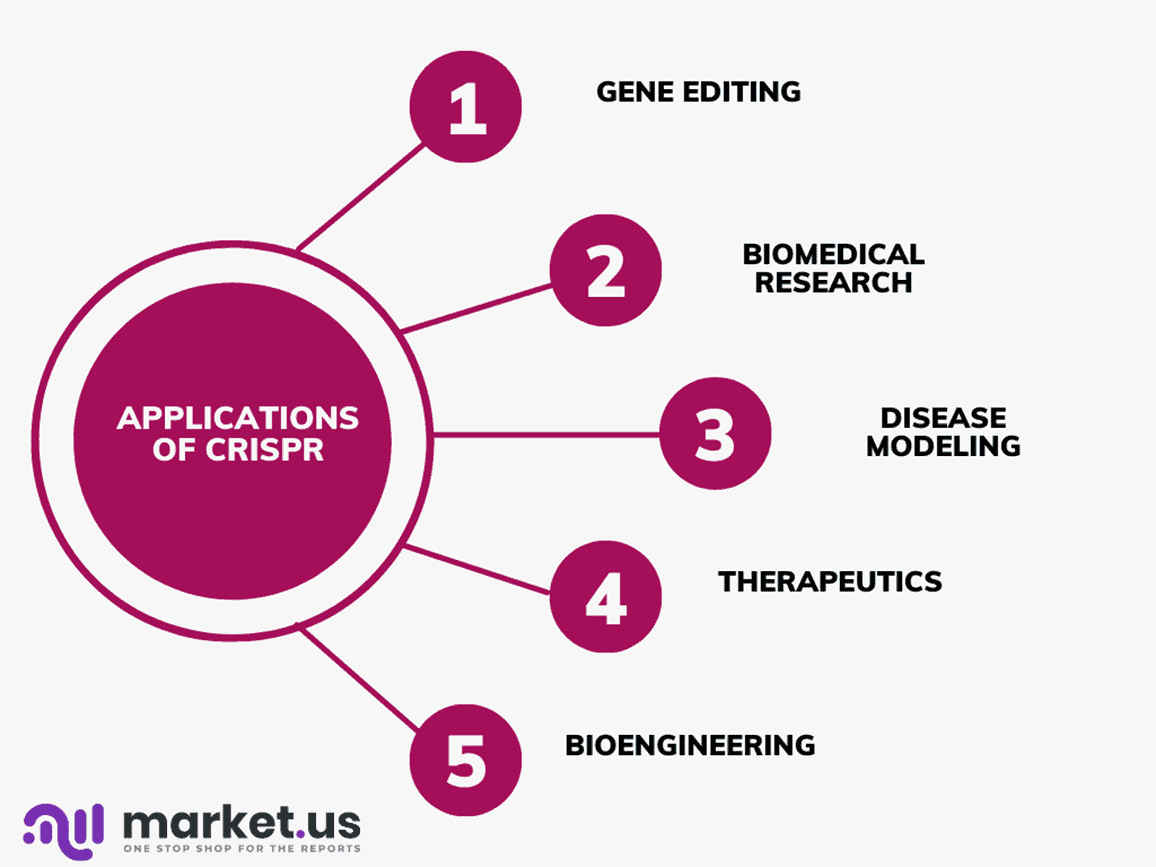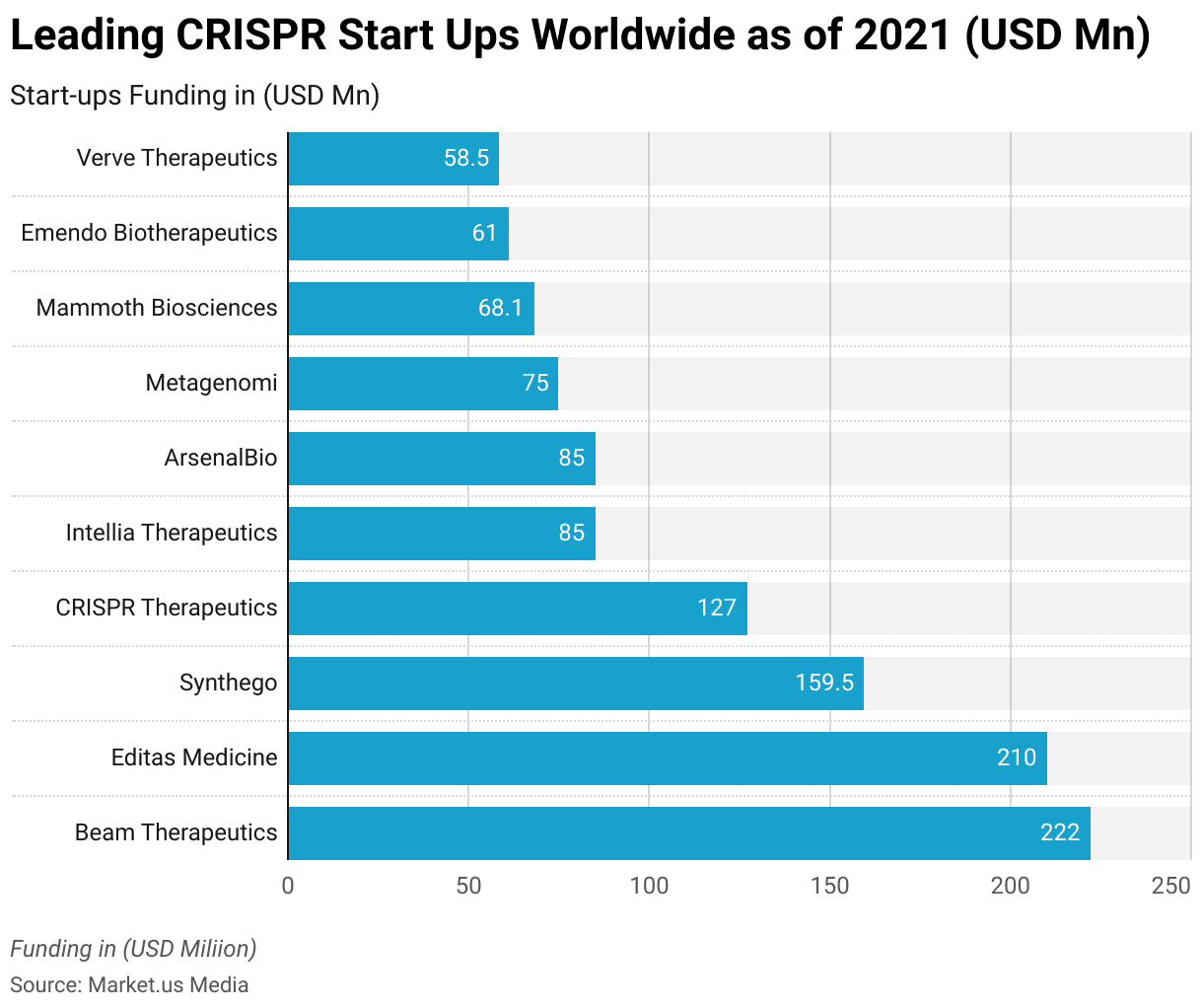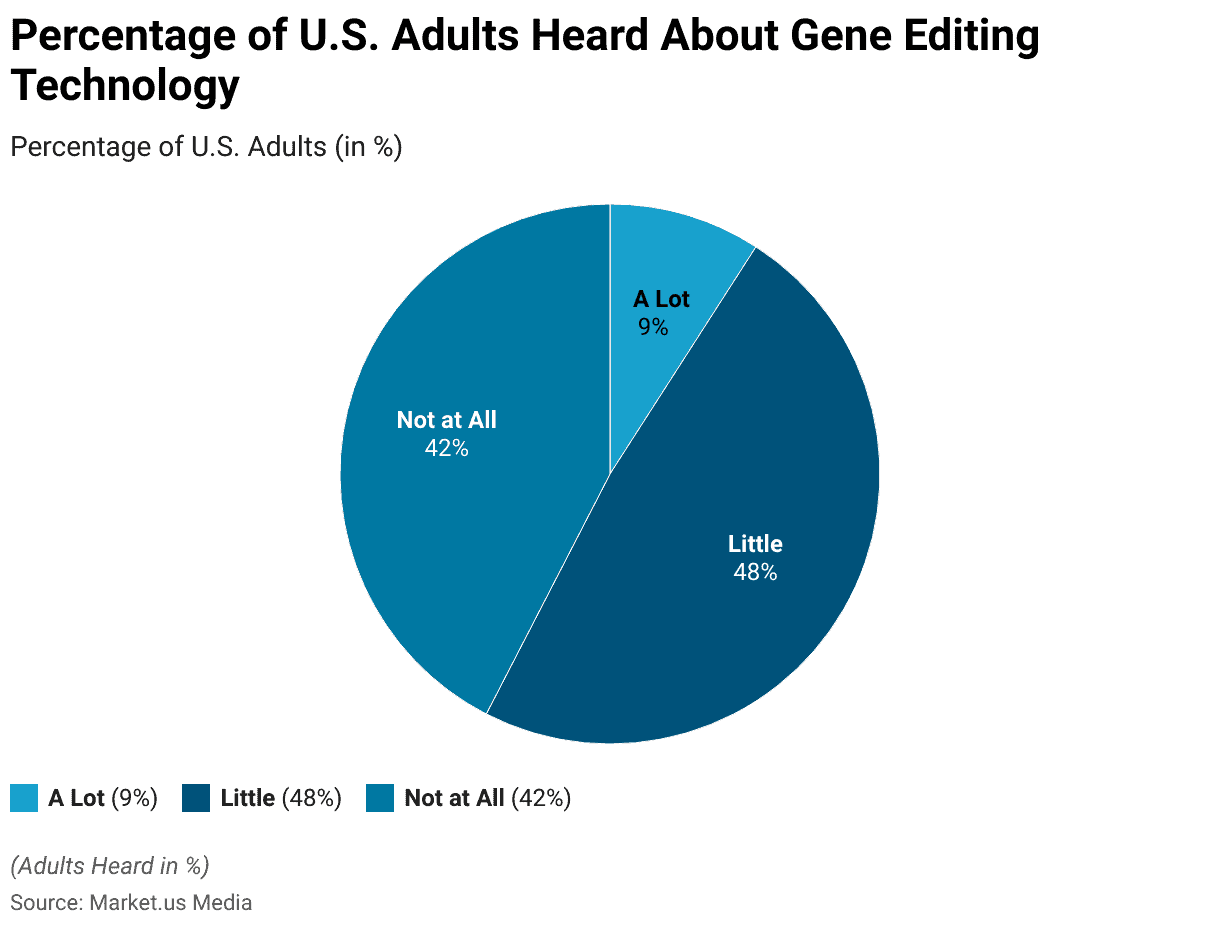Table of Contents
- Overview
- Editor’s Choice
- What is CRISPR Technology?
- Key Facts – CRISPR Statistics
- CRISPR Statistics – Success Rate
- NIH Funding for CRISPR-Related Research
- CRISPR Statistics – Related Scientific Publications
- Applications – CRISPR Statistics
- Private Investments in CRISPR Technology
- CRISPR Statistics, by Country
- Benefits of CRISPR Technology in COVID-19
- Challenges in CRISPR Gene Editing Technology
- Recent Developments
- Wrap Up
- FAQs
Overview
CRISPR Statistics: The 21st century is the era of technological advancements and automation in nearly all fields including the healthcare industry.
The recent technological advancements in clinical research and biotechnology changed the overall view of DNA sequencing.
CRISPR is already recognized as one of the most significant and effective tools in the world of genome sequencing.
Jennifer Doudna and Emmanuelle Charpentier were awarded the Nobel Prize in Chemistry in 2020 for their pioneering work on CRISPR-Cas9 gene editing.

Editor’s Choice
- The global CRISPR Technology Market accounted for a revenue of USD 3.2 billion in 2023, and the market is projected to grow at a revenue of USD 15 billion by 2033.
- CRISPR technology has revolutionized genetic research, leading to more than 10,000 publications on its applications and potential.
- Clinical trials using CRISPR-based therapies have shown promising results, with over 100 ongoing clinical trials worldwide, which are targeting a variety of genetic disorders and diseases.
- There are more than 1,000 patents of CRISPR granted globally, which indicates intense interest and commercial potential of CRISPR.
- Ethics and policy in CRISPR have gained significant traction with more than 50 countries across the globe implementing guidelines and regulations to address ethical concerns.
- Investments in CRISPR are increasing and are now reaching billions of dollars, with major funding from government agencies, biotech companies, and venture capital funds.
- The CRISPR technology is accelerated in leading countries such as the United States, China, and the United Kingdom.
- The efficiency of CRISPR-mediated gene editing is increasing, with success rates ranging from 50% to 90% in different experimental setups.
(Source: Statista)
What is CRISPR Technology?
CRISPR stands for Clustered Regulatory Interspaced Short Palindromic Repeats, which is a revolutionary gene-editing technology in the healthcare system. CRISPR allows scientists to make precise changes to the DNA of living organisms including plants, animals, and human beings.
The CRISPR-Cas9 system, the most commonly used CRISPR system, consists of two main components: Cas9 protein and small guide RNA (sgRNA).
Take advantage of our unbeatable offer - buy now!

The Cas9 protein acts as a pair of molecular scissors that can cut the DNA at a specific location determined by the sgRNA. By introducing the desired changes to the sgRNA, scientists can direct the Cas9 protein to target specific genes in the DNA sequence.
Key Facts – CRISPR Statistics
- CRISPR is derived from a natural defense mechanism found in bacteria. It was first discovered in the late 1980s but gained significant attention in the early 2020s for its potential applications in gene editing.
- CRISPR has revolutionized gene editing due to its relative simplicity and cost-effectiveness compared to previous gene editing methods.
- CRISPR was first discovered in bacteria as a natural defense mechanism against viral infections in the early 2000s.
- CRISPR-Cas9 works by using a guide RNA molecule to target a specific sequence of DNA and the Cas9 enzyme to cut the DNA at that location.
- CRISPR has quickly gained popularity among scientists due to its simplicity, cost-effectiveness, and high efficiency compared to previous gene-editing techniques.
- The potential of CRISPR for editing human germline cells, which would result in heritable changes passed down to future generations, raises ethical concerns.
CRISPR Statistics – Success Rate
- North America is dominant in the gene editing market due to higher technological advancements.
- The market in India accounted for revenue of USD 3.19 billion in 2017 and it grew to revenue of USD 6.28 billion by 2022, with a CAGR of 14.5%.
- The Parker Institute for Cancer Immunotherapy was created with a $250 million grant from the Parker Foundation in April 2016 to conduct the first human clinical trials with CRISPR technology targeted against three types of cancer.
- NIH funding for CRISPR-related research grew from more than $5 million in FY2011 to $1.1 billion in FY2018. Similarly, the number of CRISPR-related scientific publications increased from 87 in 2011 to 3,917 in 2018.
(Source: sgp)
NIH Funding for CRISPR-Related Research
| Fiscal Year | Number of CRISPR Projects | Total Funding (Dollars) |
| 2011 | 7 | $5,070,129 |
| 2012 | 9 | $7,432,520 |
| 2013 | 30 | $12,505,507 |
| 2014 | 161 | $85,298,742 |
| 2015 | 551 | $267,055,410 |
| 2016 | 1,245 | $603,205,999 |
| 2027 | 2,031 | $947,465,783 |
| 2018 | 2,651 | $1,155,385,840 |
| 2019 | 7 | $5,070,129 |
(Source: sgp)
CRISPR Statistics – Related Scientific Publications
| Year | Number of Publications |
| 2011 | 87 |
| 2012 | 137 |
| 2013 | 300 |
| 2014 | 670 |
| 2015 | 1,457 |
| 2016 | 2,594 |
| 2017 | 3,738 |
| 2018 | 3,917 |
| Total | 12,900 |
(Source: sgp)
Applications – CRISPR Statistics
- Gene Editing: CRISPR can be used to edit genes in various organisms, from plants and animals to humans. Offering the potential to treat genetic diseases by correcting or altering any faulty genes responsible for that disease.
- Biomedical research: CRISPR allows scientists to investigate gene function by selectively disabling or altering them in model organisms. This helps provide insights into gene functions and potential therapeutic targets.
- Disease Modeling: CRISPR allows researchers to use animal models with specific genetic mutations for disease modeling and testing potential treatments. Giving key insight into understanding disease mechanisms while creating new therapies.
- Therapeutics: CRISPR-based therapies hold promise for treating genetic disorders and some types of cancer. Researchers explore methods such as gene replacement, correction, regulation, and maintenance as potential treatment solutions.
- Bioengineering: CRISPR can be used to engineer microorganisms for various uses, including producing biofuels or developing new drugs; or synthesizing valuable chemicals.

Private Investments in CRISPR Technology
CRISPR has attracted significant attention and investments from both private and public sources. Since its discovery, numerous biotechnology companies and research institutions have pursued CRISPR-related projects, leading to substantial investments in the field.
CRISPR Statistics – Leading CRISPR start-ups worldwide (2021)
- Beam Therapeutics was the leading company in the CRISPR gene editing market with funding of USD 222 million in 2022.
- Editas Medicine was the second leading company in funding for CRISPR technology which funded approximately USD 210 billion in 2021.
(Source: Statista)
CRISPR Statistics illustrates the leading CRISPR start-ups worldwide as of 2021, by funding

Editas Medicine (headquartered in Cambridge, MA)
- Editas Medicine has a pipeline of potential therapies targeting various genetic diseases. Their lead program is EDIT-101, an investigational gene-editing treatment for a rare inherited retinal disease called Leber congenital amaurosis type 10 (LCA10). EDIT-101 aims to correct a specific genetic mutation in the CEP290 gene, which is associated with LCA10.
- Editas Medicine raise approximately USD 97.5 million in 2016 for CRISPR technology and research.
- As of November 15, 2018, the company’s market capitalization was $1.34 billion.
- In January 2018, the company completed at-the-market offerings and received net proceeds of approximately $48.5 million.
- Editas has also engaged in a three-year research and development (R&D) collaboration deal with San Raffaele Telethon Institute for Gene Therapy to research and develop next-generation stem cell and T-cell therapies for the treatment of rare diseases.
- In 2021, Editas Medicine funding for CRISPR gene editing technology was USD 210 million which is about 5 times more as compared to 2017 funding.
(Source: sgp, Statista)
CRISPR Therapeutics AG
- CRISPR Therapeutics has a robust clinical pipeline of investigational therapies. In September 2021, the company has ongoing clinical trials for several programs. Including CTX001 for the treatment of beta-thalassemia and sickle cell disease. CTX110 for the treatment of relapsed or refractory CD19+ B-cell malignancies. CTX120 for the treatment of relapsed or refractory multiple myeloma.
- The company has raised a total of almost $140 million, including a $38 million B-series round of financing in June 2016.
- The company raised additional funding of USD 122 million in January 2018 and USD 187.6 million in September 2018.
- The total funding of CRISPR Therapeutics in 2021 was approximately USD 127 million.
(Source: sgp, Statista)
Beam Therapeutics
- Beam Therapeutics has attracted substantial funding from various sources to support its research and development efforts.
- In 2018, Beam Therapeutics raised $87 million in a Series A financing round led by F-Prime Capital Partners and Arch Venture Partners, among other investors.
- In February 2020, Beam Therapeutics went public on the Nasdaq Global Market under the ticker symbol “BEAM.” The company raised approximately $180 million through its Initial Public Offering (IPO).
- In December 2020, Beam Therapeutics conducted a follow-on offering and raised approximately $325 million.
- As of April 2021, Beam Therapeutics was the top CRISPR start-up worldwide by funding, at USD 222 million.
(Source: sgp, Statista)
CRISPR Statistics, by Country
The United States
The United States has been a major hub for CRISPR research and development. Numerous academic institutions, including the Broad Institute, University of California, Berkeley, and Harvard University, have made significant contributions to advancing CRISPR technology.
The Pew Research Center survey gauged, in broad terms, what the public thinks about the potential use of gene editing to enhance people’s health.
According to Pew Research,
- Most of the US adults (about 48%) heard a little about gene editing technology.
- About 42% of US adults have not at all heard about CRISPR gene editing technology.
- Only 9% of US adults heard about CRISPR technology a lot.
(Source: Pew Research)

China
China has played a significant role in the development and application of CRISPR technology. Chinese scientists have been actively involved in CRISPR research and have made several notable contributions.
- In 2015, Chinese scientists made headlines when they reported the successful use of CRISPR-Cas9 to modify the DNA of human embryos. This study, led by Dr. Jiankui He, aimed to introduce a mutation in the CCR5 gene associated with HIV resistance.
- According to a study published in the journal Nature Biotechnology in 2019. China accounted for the highest number of CRISPR publications globally.
Germany
German researchers have been actively involved in studying the mechanism of CRISPR-Cas9 and exploring its potential applications.
- German universities and research institutes such as the Max Plank Society and Helmholtz Association have been playing a crucial role in CRISPR gene editing technology.
- Key companies in CRISPR technology such as CRISPR Therapeutics AG, Evotec SE, InSCREENeX GmbH, Editas Medicine GmbH, and CRISPR GmbH fuelling the research and development activities in CRISPR gene editing technology in Germany.
Benefits of CRISPR Technology in COVID-19
- Rapid Diagnostic Testing: Researchers have developed CRISPR-based diagnostic tests for COVID-19. Two examples include Sherlock Biosciences’ SHERLOCK(tm) (Specific High Sensitivity Enzymatic Reporter Unlocking) and Mammoth Biosciences’ DETEC TR(tm) systems from Mammoth Biosciences that utilize CRISPR technology to detect SARS-CoV-2 DNA present in patient samples faster, potentially more accurately, and easily saleable than traditional RT-PCR tests for more widespread testing.
- Understanding COVID-19 Pathogenesis: Researchers have used CRISPR technology to identify potential drug targets for COVID-19 by uncovering the human genes that the virus utilizes to infect human cells.
- Surveillance of Virus Variants: CRISPR-based diagnostic tools may also be utilized as genomic surveillance tools to track the spread of various SARS-CoV-2 variants and thus inform public health decisions and potentially change infection and mortality statistics.
Challenges in CRISPR Gene Editing Technology
- Off-Target Effects: One of the primary risks of CRISPR technology is its potential to unintentionally edit “off-target” genes that were not intended to be altered, which could potentially have adverse consequences, leading to cell dysfunction, disease progression, or other unpredictable results.
- Delivery: Delivery of CRISPR-Cas9 to target cells remains a formidable challenge. Current methods of delivery, which include viral vectors, microinjection, and electroporation, all come with their own set of constraints that may or may not work effectively. For instance, viral vectors may trigger an immune response while Cas9 proteins’ size may limit incorporation into certain vectors. Non-viral methods may be less efficient and more stressful on cells.
- Limited Editing Efficiency: CRISPR-Cas9 doesn’t always successfully edit its target gene. Sometimes it introduces unintended insertions or deletions at its target site (indels), leading to frameshift mutations and other issues.
- In Vivo Editing: CRISPR technology has demonstrated considerable promise in editing genes within living organisms (in vitro). Unfortunately, translating that technology to editing DNA within living organisms (in vivo) presents its own set of unique challenges. Delivery of CRISPR-Cas9 can be more difficult inside an organism; there may also be concerns regarding off-target effects.
- P53 Activation: Studies indicate that CRISPR-Cas9 may activate p53. An essential protein in cancer prevention that repairs DNA damage or destroys cells if the damage becomes too great. This may limit its effectiveness or select for cells with dysfunctional p53 proteins – leading to higher risks of becoming cancerous cells.
Recent Developments
Acquisitions and Mergers:
- HealthTech Inc. acquired PrecisionCare Solutions for $800 million, consolidating its position in the precision medicine market and expanding its portfolio of personalized healthcare services.
- BioMed Innovations merged with GenomicHealth Technologies, forming a strategic partnership to advance precision medicine research and development efforts, with combined expertise in genetic testing and analysis.
New Product Launches:
- GenoMed unveiled a next-generation sequencing platform for genetic testing, offering comprehensive DNA analysis and personalized treatment recommendations, aiming to reach 1 million tests processed within the first year.
- Therapix introduced a precision oncology therapy targeting specific genetic mutations, demonstrating promising results in clinical trials with a 60% improvement in progression-free survival rates.
Funding Rounds:
- PrecisionCure received $150 million in Series C funding led by Healthcare Investment Group to expand their precision medicine platform and invest in artificial intelligence algorithms for data analysis, aiming for a 50% increase in patient enrollment within the next year.
- GeneHealth secured $80 million in seed funding from Biotech Investors to develop innovative diagnostics for rare genetic disorders and establish partnerships with pharmaceutical companies for precision medicine research, aiming for a 40% growth in revenue over the next fiscal year.
Consumer Trends:
- Rising awareness of personalized healthcare and genomic testing fueled the demand for precision medicine services. Genetic testing sales increased by 30% compared to the previous year.
- Adoption of precision oncology therapies surged, with a 40% increase in prescriptions for targeted cancer treatments. Reflecting growing acceptance of precision medicine approaches in oncology practice.
Regulatory Landscape:
- Regulatory agencies implemented guidelines for genetic testing and precision medicine applications. Ensuring adherence to quality standards and patient safety in the precision medicine market.
Wrap Up
CRISPR Statistics – CRISPR has a wide range of potential applications, including medical research, agriculture, and environmental conservation.
In the field of medicine, CRISPR has the potential to revolutionize treatments for genetic disorders by editing faulty genes directly.
It offers the possibility of precise gene therapies and the potential to cure diseases that were previously considered untreatable.
Since its discovery, CRISPR technology has rapidly advanced, and scientists continue to refine and expand its capabilities.
New variations of CRISPR systems, such as prime editing and base editing. It has been developed to further enhance precision and reduce potential off-target effects.
Overall, CRISPR holds tremendous promise for scientific research, medicine, and various industries, as research and development continues.
It is expected to have a significant impact on our understanding of genetics and the ability to manipulate DNA for beneficial purposes.
FAQs
CRISPR (Clustered Regularly Interspaced Short Palindromic Repeats) is a revolutionary gene-editing tool. It is a system that was initially discovered in bacteria. Which they use as a kind of immune system to defend against viral attacks. Scientists have harnessed this system to selectively edit genes in a wide variety of organisms.
CRISPR is a highly versatile and efficient gene-editing tool, but there are other gene-editing techniques as well. Some alternatives include zinc finger nucleases (ZFNs) and transcription activator-like effector nucleases (TALENs). However, these techniques are generally more complex and less efficient compared to CRISPR.
CRISPR faces several challenges. Off-target effects, where unintended changes are made in the genome, are a concern that needs to be addressed. Delivery of CRISPR components into target cells or tissues can also be challenging. Ethical considerations and regulatory frameworks must keep pace with advancements in CRISPR technology to ensure responsible and equitable use.
Discuss your needs with our analyst
Please share your requirements with more details so our analyst can check if they can solve your problem(s)



